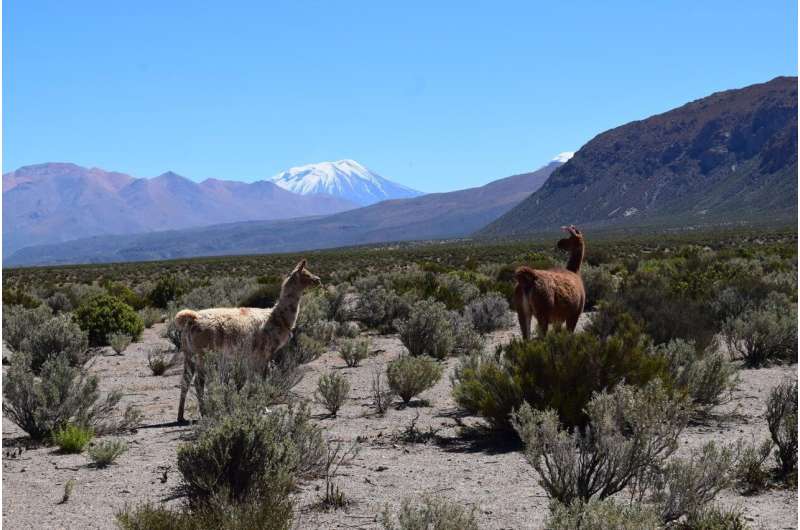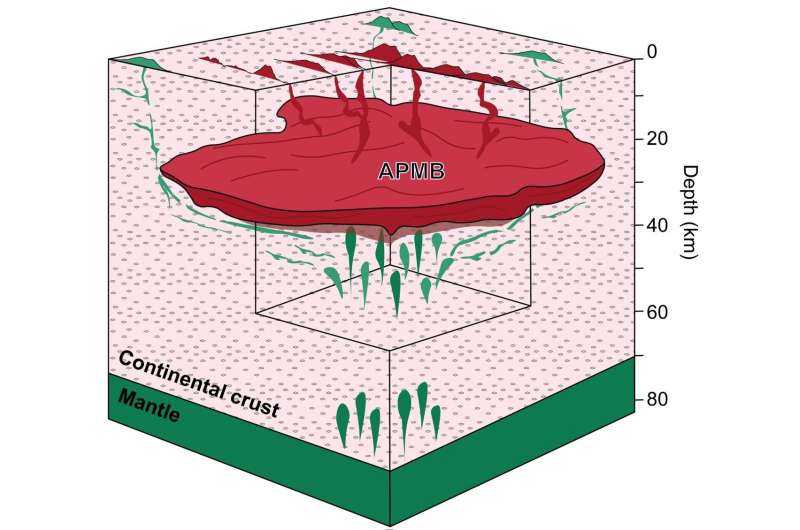New study takes the pulse of a sleeping supervolcano

Under the volcanoes in the Andes where Chile, Argentina and Bolivia meet, there is a gigantic reservoir of molten magma. For several million years, it has been there without fully solidifying or causing a supervolcanic eruption. Geologists have long wondered how this is possible. Researchers from Uppsala University, among others, have now discovered that the secret may be hidden tributaries of hot magma from inside the Earth. The study is published in the journal Scientific Reports.
"Huge volcanic eruptions from so-called supervolcanoes are very unusual, but when they happen they are extremely devastating. It's incredibly important for volcanologists to clarify what keeps this sleeping giant alive and what can cause it to awaken," says Valentin Troll, Professor of Petrology at the Department of Earth Sciences at Uppsala University.
The giant so-called Altiplano-Puna magma body is estimated to contain 500,000 cubic kilometers of molten and semimolten magma. In order to provide a picture of how much volume is involved, it can be said that the entire island of Gran Canaria would fit inside—more than ten times over. The last really large volcanic eruption here occurred 4 million years ago and was the last in a series of very large explosive eruptions that began 10 million years ago. Some of them can be classified as supervolcanic eruptions.
In order to look for answers as to how the magma could stay molten for millions of years, the researchers studied lavas that were ejected from the magma reservoir during smaller volcanic eruptions after the last major eruption. The chemical composition of such material can provide an indication of how a magma reservoir works, how far down from inside the Earth the material originates, how long it remained in the reservoir and what different processes the magma underwent before it was ejected by the volcano.

In this case, the researchers wants to find out if new magma forces its way into the reservoir and therefore needed to find material that, after forming in the Earth's mantle, was not affected by interaction with the magma that was already in the reservoir.
"This was a demanding task. Under these particular volcanoes in the Central Andes is the Earth's thickest crust, 70 kilometers thick, which means that the magma is given many chances to change and react with the material it comes into contact with when it forces its way up to the surface," says Frances Deegan, a researcher at Uppsala University.
The researchers therefore searched several years for lava that was as "original" as possible. Finally, they found what they were looking for. They have now analyzed the composition of the oxygen isotopes in their samples to find out how lavas were formed and where they originate from. The results showed that the lavas came from deep within the Earth and that they represent the material that feeds the volcanoes of the Central Andes, keeping them alive.
This new knowledge is important to understanding how large, complex volcanoes work.
"Supervolcanic eruptions can cause gigantic disasters. The last one that happened on the Earth was Toba's super eruption in Indonesia 73,000 years ago and it is considered to have almost led to the extinction of mankind. Even if we can't prevent a super eruption from happening, it would be smart to use the time until the next eruption to learn as much as possible to increase the chances for our communities to survive such an event," says Valentin Troll.
More information: Osvaldo González-Maurel et al, Constraining the sub-arc, parental magma composition for the giant Altiplano-Puna Volcanic Complex, northern Chile, Scientific Reports (2020). DOI: 10.1038/s41598-020-63454-1
Journal information: Scientific Reports
Provided by Uppsala University





















